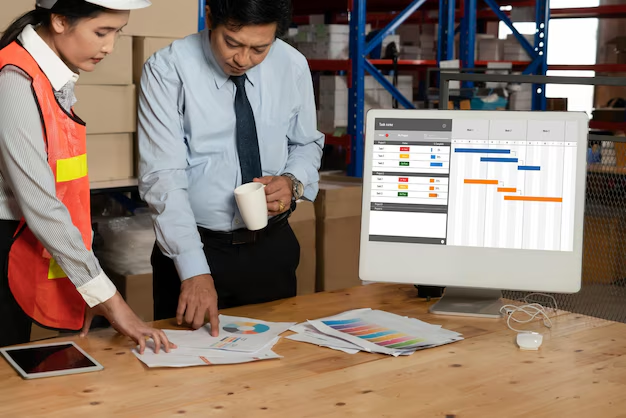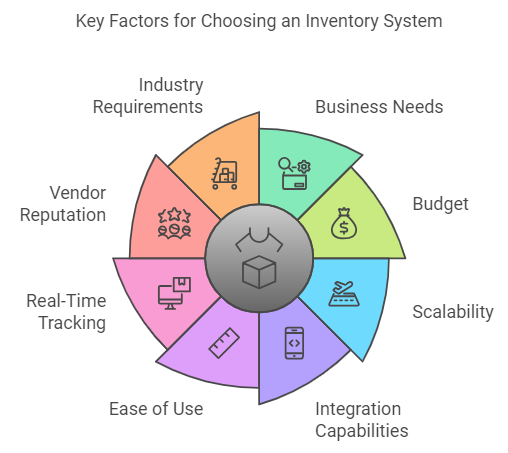Efficient inventory management is the cornerstone of a successful business as it ensures products are available to meet customer demand without the need for overstocking.
However, with various inventory management systems already available today, choosing the right one can make all the difference, as it can significantly impact your business’s operational efficiency and profitability.
Hence, in this article, we will explore the different types and methods of inventory management systems available in the Philippines and provide real-world examples to illustrate their application.
It doesn’t really matter whether you are a small retailer or a large manufacturer, as understanding these systems will help streamline the inventory processes of your business immeasurably and boost your bottom line. So, without much ado, let us explore all the key details regarding efficient inventory management systems.

What is Efficient Inventory Management, And Why is it Important For Philippine Businesses?

Efficient inventory management is the strategic approach to overseeing and controlling the storage, ordering, and usage of a company’s inventory. This process ensures that the right amount of stock is maintained to meet customer demand without overstocking or understocking, which can lead to increased costs or lost sales.
Efficient inventory management usually involves businesses using various techniques and tools to forecast demand accurately, streamline supply chain operations, and optimize stock levels to make sure no unnecessary stock is ordered or stored.
Here, take a look at some of the key importance of efficient inventory management for Philippine businesses -
1. Cost Reduction
Efficient inventory management is crucial for reducing costs, which is especially important for businesses in the Philippines, where resources may be limited.
Businesses can avoid unnecessary storage costs and reduce the risk of obsolete stock by accurately tracking inventory levels and ensuring that stock is neither over-ordered nor under-ordered,
This cost efficiency translates into better financial health and allows businesses to allocate resources more effectively.
2. Enhanced Customer Satisfaction
Maintaining high customer satisfaction is key to business success, and efficient inventory management ensures that products are always available to meet customer demand, minimizing stockouts and backorders.
By providing reliable product availability, businesses can build customer trust and loyalty, leading to repeat business and positive word-of-mouth referrals.
3. Improved Cash Flow
Proper inventory management directly impacts a business's cash flow, as Philippine businesses can free up capital that would otherwise be tied up in unsold inventory by optimizing stock levels.
This improved cash flow can be reinvested into other critical areas of the business, such as marketing, technology upgrades, or expansion initiatives, fostering overall business growth.
4. Operational Efficiency
Efficient inventory management streamlines operations, reducing the time and effort required to manage stock. For businesses in the Philippines, this means fewer administrative headaches and more time to focus on core activities like sales and customer service.
Streamlined operations also reduce the risk of human errors in inventory tracking, leading to more accurate records and better decision-making.
5. Competitive Advantage
In a market with numerous competitors, having an efficient inventory management system can provide a significant competitive advantage.
Philippine businesses that can manage their inventory effectively are better positioned to respond quickly to market changes, introduce new products, and meet customer demands faster than their competitors.
6. Scalability
As Philippine businesses grow, their inventory management needs become more complex. Efficient inventory management systems are scalable and can adapt to the increasing demands of a growing business.
This scalability ensures that businesses can continue to operate smoothly and maintain control over their inventory, even as they expand into new markets or increase their product lines.
Also Read: Types of Business Loans in the Philippines
Types of Inventory Management Systems And Methods Commonly Used By Businesses In The Philippines
Philippine businesses face unique challenges in managing their inventory efficiently to stay competitive and meet customer demands. Hence, selecting the right inventory management system and method is crucial for them to optimize stock levels, reduce additional costs, and enhance their operational efficiency.
So, to help Philippine businesses in their journey, this article will provide an overview of the various types of inventory management systems and methods commonly used by businesses in the Philippines. This will help them select the best approach to streamline their inventory processes and drive business growth.
Types of Inventory Management Systems Used By Philippine Businesses
1. Perpetual Inventory System
The perpetual inventory system continuously updates inventory records with each purchase or sale. This real-time tracking provides businesses with accurate inventory levels at any given time.
For Philippine businesses, this system is particularly beneficial for maintaining tight control over stock and reducing the risk of overstocking or stockouts. Retailers and e-commerce platforms often use this system to ensure they can promptly respond to customer demands.
2. Periodic Inventory System
In the periodic inventory system, inventory levels are updated at specific intervals, such as monthly or quarterly. This method is less technology-intensive and is often used by smaller businesses or those with limited resources.
While it may not provide the real-time accuracy of a perpetual system, it allows Philippine businesses to manage inventory without the need for constant monitoring, reducing operational complexity.
Also Read: Benefits and Disadvantages of Small Business Loans
Inventory Management Techniques Commonly Used By Businesses in The Philippines
1. Economic Order Quantity (EOQ)
The Economic Order Quantity (EOQ) method helps businesses determine the optimal order quantity that minimizes the total costs of inventory, including ordering and holding costs. This method uses a mathematical formula to calculate the most cost-effective number of units to order.
Philippine businesses, especially those with stable demand, can benefit from EOQ by reducing excess inventory and optimizing their ordering process.
2. Just-In-Time (JIT)
Just-In-Time (JIT) inventory management focuses on ordering inventory only when it is needed for production or sales. This method reduces holding costs and minimizes waste, making it ideal for businesses with reliable suppliers and accurate demand forecasting.
Philippine businesses, particularly in manufacturing and retail, can use JIT to enhance efficiency and reduce inventory costs.
3. ABC Analysis
ABC Analysis categorizes inventory into three classes based on their value and significance: A (high-value), B (moderate-value), and C (low-value). This method allows businesses to prioritize their management efforts on the most critical items.
Philippine businesses can use ABC Analysis to allocate resources more effectively, ensuring that high-value items receive more attention and control.
4. Safety Stock Inventory
Safety Stock Inventory involves maintaining a buffer stock to protect against uncertainties in demand and supply. This method ensures that businesses can meet customer demand even in the face of supply chain disruptions.
For Philippine businesses, safety stock can be crucial in managing the risks associated with supply chain variability and market fluctuations.
5. First-In, First-Out (FIFO)
First-In, First-Out (FIFO) assumes that the oldest inventory items are sold first. This method is particularly useful for businesses dealing with perishable goods or products with a limited shelf life.
Philippine businesses in the food and beverage industry, for example, can use FIFO to minimize spoilage and ensure that older stock is sold before newer stock.
6. Last-In, First-Out (LIFO)
Last-In, First-Out (LIFO) assumes that the most recently acquired inventory items are sold first. This method can be advantageous for businesses facing rising costs, as it matches the most recent costs against current revenues.
While less commonly used due to accounting and tax implications, some Philippine businesses might find LIFO beneficial in specific scenarios.
7. Drop Shipping
Drop shipping involves selling products without holding inventory. When a sale is made, the product is shipped directly from the supplier to the customer. This method reduces inventory holding costs and eliminates the need for warehousing.
Philippine e-commerce businesses can leverage drop shipping to offer a wide range of products without the overhead of inventory management.
8. Bulk Shipments
Bulk shipments involve ordering and receiving inventory in large quantities. This method can reduce shipping costs and take advantage of bulk purchasing discounts.
Philippine businesses, particularly those with predictable demand and storage capacity, can benefit from bulk shipments by lowering per-unit costs and ensuring adequate stock levels.
9. Vendor-Managed Inventory (VMI)
Vendor-Managed Inventory (VMI) is a collaborative approach where the supplier manages the inventory levels for the business. This method can improve supply chain efficiency and reduce the burden of inventory management on the business.
For Philippine businesses with strong supplier relationships, VMI can lead to better inventory turnover and reduced stockouts.
10. Consignment Inventory
Consignment inventory involves placing products in the business’s inventory but retaining ownership until they are sold. The supplier assumes the risk of unsold inventory, while the business only pays for what it sells.
Philippine retailers can use consignment inventory to expand their product offerings without the financial risk of unsold stock.
Also Read: Startup Business Loans: How to Get Them for Your Business Needs
Empower Your Philippine SME with N90’s Fast Financing Solutions! Apply online in minutes and get potential approvals within 24 hours. Start now!
Top Inventory Management Systems Examples in The Philippines

1. SM Retail
SM Retail, one of the largest retail chains in the Philippines, employs a sophisticated inventory management system that integrates real-time data analytics and automated replenishment.
It ensures that inventory levels are constantly updated and optimized by using a perpetual inventory system combined with barcode scanning. This allows SM to maintain high product availability and customer satisfaction while minimizing excess stock and reducing holding costs.
2. Jollibee Foods Corporation
Jollibee, a leading fast-food chain in the Philippines, uses a Just-In-Time (JIT) inventory management system to streamline its supply chain operations. This system ensures that ingredients and supplies are delivered exactly when needed, reducing waste and holding costs.
Jollibee's efficient inventory management contributes to its ability to maintain consistent product quality and service speed across its numerous branches.
3. Mercury Drug
Mercury Drug, a major pharmaceutical retailer in the Philippines, utilizes an effective inventory management system that combines ABC Analysis and batch tracking. It prioritizes high-value and time-sensitive items by categorizing inventory based on value and expiration dates.
The batch tracking system enhances traceability and ensures the goods comply with the required regulatory standards, which is crucial for maintaining the safety and efficacy of pharmaceutical products.
4. Puregold Price Club
Puregold, a prominent supermarket chain in the Philippines, utilizes an Economic Order Quantity (EOQ) inventory management technique. This system helps Puregold determine the optimal order quantities to minimize the total costs associated with ordering and holding inventory.
Puregold efficiently manages its diverse product range by using EOQ to ensure that shelves are always stocked without overburdening storage facilities.
5. Lazada Philippines
Lazada, a leading e-commerce platform in the Philippines, employs a cloud-based inventory management system which integrates with Lazada's sales platform to provide real-time updates on inventory levels across multiple warehouses.
The cloud-based solution enables efficient inventory tracking, automated reordering, and seamless integration with suppliers to ensure that Lazada can meet the dynamic demands of online shoppers and manage inventory across its extensive distribution network.
6. Bench
Bench, a popular clothing brand in the Philippines, uses a combination of First-In, First-Out (FIFO) and RFID inventory systems.
The FIFO method ensures that older inventory is sold first, reducing the risk of obsolescence. On the other end, the RFID technology provides real-time visibility into inventory levels and movement, enhancing stock accuracy and reducing shrinkage.
Bench's integrated approach allows for efficient inventory turnover and improved customer satisfaction.
7. Ace Hardware Philippines
Ace Hardware, a well-known hardware retailer, uses a Vendor-Managed Inventory (VMI) system to streamline its inventory processes. In this system, suppliers manage inventory levels based on agreed-upon metrics and sales data.
This collaborative approach reduces stockouts and excess inventory, ensuring that Ace Hardware can provide a wide range of products without overloading its storage capacity.
8. Cebu Pacific Air
Cebu Pacific, a leading budget airline in the Philippines, applies an advanced inventory management system for its spare parts and maintenance supplies.
It ensures that critical parts are available when needed by using predictive analytics and automated replenishment, thereby minimizing aircraft downtime. This system enhances operational efficiency and supports the airline's commitment to safety and reliability.
Also Read: Best Short-Term Business Loans for Fast Financing
How To Choose the Right Inventory Management System For Your Philippine Business - Key Points To Consider
Selecting the appropriate inventory management system for optimizing business operations and minimizing costs is crucial, and with numerous options already available, making the best decision can be quite challenging.
To help you with this decision, in this section of the article, we will take a look at the key factors to consider when choosing the right inventory management system for your Philippine business.
Here, let us explore the essential criteria for choosing the best inventory management system to suit the unique requirements of your Philippine business -

1. Assess Your Business Needs
Begin by evaluating your specific inventory management requirements by taking a look at the size of your business, the volume of inventory, and the complexity of your supply chain.
A small retail store may have different needs compared to a large manufacturing firm, so identify key pain points in your current system, such as overstocking, stockouts, or manual errors, to determine what features you need in a new system.
2. Determine Your Budget
Establish a budget for your inventory management system. Costs can vary significantly depending on the complexity and capabilities of the system, so include not only the initial investment but also ongoing costs such as subscription fees, maintenance, and potential upgrades.
Moreover, also ensure that the system you choose provides good value for money and fits within your financial constraints.
3. Look for Scalability
Choose a system that can grow with your business. As your operations expand, your inventory management needs will become more complex, so selecting a scalable system will accommodate increased inventory volumes, more users, and additional locations without compromising performance.
This flexibility will save you from having to switch systems as your business evolves.
4. Evaluate Integration Capabilities
Ensure the inventory management system can integrate seamlessly with your existing business software, such as your accounting, ERP, or e-commerce platforms.
Integration streamlines data flow, reduces manual data entry, and enhances overall efficiency, so selecting a system that works well with your current tools will help maintain consistency and accuracy across all your business processes.
Also Read: Applying for a Small Business Loan: 5 Steps to Get Approved
5. Consider Ease of Use
Select a system that is user-friendly and easy to implement, as complex systems can lead to a steep learning curve and decreased productivity.
Additionally, look for intuitive interfaces, comprehensive training resources, and strong customer support to ensure your team can quickly adapt and effectively use the system.
6. Check for Real-Time Tracking and Reporting
Real-time tracking and reporting capabilities are essential for maintaining accurate inventory levels and making informed decisions, so ensure the system you select provides real-time updates on stock movements, order statuses, and inventory levels.
Enabling detailed reporting features will help you analyze trends, forecast demand, and identify areas for improvement for your business.
7. Assess Vendor Reputation and Support
Research potential vendors and assess their reputation in the market. Always look for customer reviews, case studies, and testimonials to gauge their reliability and service quality.
Additionally, strong customer support is another crucial factor for resolving issues quickly and ensuring smooth operation, so it is always a good idea to select a vendor with a proven track record and a responsive support team.
8. Consider Specific Industry Requirements
Different industries have unique inventory management needs. For instance, food and beverage businesses may require features for tracking expiration dates, while electronics retailers might need advanced serial number tracking.
Always ensure the system you choose caters to the specific requirements of your industry to maximize its effectiveness.
9. Explore Cloud-Based Options
Cloud-based inventory management systems offer several advantages, including remote access, automatic updates, and scalability. They eliminate the need for extensive IT infrastructure and provide flexibility for businesses with multiple locations.
Consider cloud-based solutions for their ease of use and cost-effectiveness.
10. Evaluate Security Features
Inventory data is critical to your business operations, so security is paramount. Choose a system with reliable security measures, such as data encryption, access controls, and regular backups.
Moreover, also ensure the vendor follows best practices for data protection to safeguard your sensitive information.
Conclusion
Effective inventory management is a cornerstone of successful business operations. By understanding the various inventory management systems and methods, businesses can optimize stock levels, reduce costs, and enhance customer satisfaction.
The choice of inventory management system depends on factors such as business size, product type, industry, and desired level of control. So, by carefully evaluating available options and implementing the most suitable approach, businesses can achieve greater efficiency, profitability, and competitive advantage.
It is worth remembering that inventory management is an ongoing process that requires continuous monitoring and adjustment to adapt to changing business conditions.
Moreover, it doesn’t matter whether you are a small retailer or a large manufacturer, as choosing the right inventory management system that aligns with your business’s approach is crucial since it has the potential to drive your business toward greater profitability and success.
Frequently Asked Questions (FAQs)
1. What are the three types of inventory management systems?
The three primary types of inventory management systems are:
- Manual Inventory System: Relies on physical counting and manual record-keeping.
- Periodic Inventory System: Involves physical counts at regular intervals to adjust inventory records.
- Perpetual Inventory System: Continuously tracks inventory levels using software, providing real-time data.
2. What is the most common method of inventory management used in the Philippines?
The most common method of inventory management in the Philippines is still manual or periodic inventory counting. This involves physically counting stock items at regular intervals to reconcile inventory records.
While this method is time-consuming and prone to errors, it's widely used due to its simplicity and lower costs for small businesses. However, as businesses grow and the complexity of inventory increases, there's a growing adoption of perpetual inventory systems and inventory management software.
3. What are the methods of inventory control?
Inventory control methods focus on monitoring and managing stock levels:
- ABC analysis: Categorizes inventory items based on value to prioritize control efforts.
- FIFO (First In, First Out): Assumes oldest items are sold first, ideal for perishable goods.
- LIFO (Last In, First Out): Assumes newest items are sold first, often used for tax purposes.
- Just-In-Time (JIT): Aim to minimize inventory by ordering goods only as needed.
- Economic Order Quantity (EOQ): Calculates optimal order size to minimize inventory costs.
- Safety Stock: Maintains a buffer of inventory to avoid stockouts.
4. What are the 4 types of inventory?
The 4 main types of inventory are -
- Raw materials: Basic inputs used in production.
- Work-in-progress (WIP): Partially completed products.
- Finished goods: Completed products ready for sale.
- Maintenance, Repair, and Operating (MRO) supplies: Items used to maintain operations, not directly involved in production.













